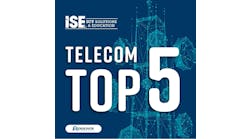Recent updates include notices from Parks Associates, Mobile Experts, Spark Mindset, Inc., Healthinsurance.com, and Visual Objects. Visit https://isemag.com/category/safety/telecom-covid-19-network-impact-wireless-wireline/ often to find more COVID-19 Impact Updates.
30% of US Broadband Households Intend to Avoid Large Gatherings of People Into 2021
New research studies highlight impact on consumer spending, broadband usage, tech purchases, and adoption and usage of home services.
New Parks Associates research finds 30% of US broadband households intend to avoid public events and large gatherings of people into 2021, due to concerns of exposure to COVID-19. The research firm is tracking the impact of the pandemic on consumer behaviors, attitudes, and intentions in the consumer and home technology markets through multiple research projects, including the series COVID-19: Impact on Consumer Behavior and Spending. This research reports consumers have cut discretionary spending by 50%, although CE and computer purchases have increased for the first time since 2011.
“70% of US broadband households believe the economy will need a long time to recover from the COVID-19 pandemic, and only 23% believe the economy will rebound quickly once social-distancing measures are lifted,” said David Drury, Research Director, Parks Associates. “With record-level unemployment and continuing uncertainty about the future, consumers have cut discretionary spending by 50%, although CE and computer purchases have increased for the first time since 2011. Due to the ongoing COVID-19 pandemic, these changes in behavior will not reverse in the near term, with 30% of households planning to avoid public events and 29% delaying vacations or personal travel till at least 2021.”
While consumers are hesitant about spending, one area with solid purchase intentions is consumer electronics and the increased consumption of video at home. During the COVID-19 crisis, 26% of US broadband households purchased electronics. Parks Associates predicts that with an ongoing global pandemic, and worsening conditions in the United States, strong demand for technology products and services will continue into 2021 and potentially even 2022, including high broadband usage at home to deliver messaging, video calling, and virtual meeting applications; video game downloads; and streaming video services. Currently, 74% of US broadband households subscribe to at least one streaming video service, and almost half of US broadband households subscribe to two or more.
Parks Associates continues to provide timely insight on consumer spending and behavior, including the long-term impact of COVID-19 on consumer spending and the use of technology in the home beyond crisis conditions with its latest research products:
• COVID-19: Impact on Communications and Entertainment
• Smart Home Tracker 2020
• COVID-19: Impact on Telehealth Use and Perspectives
• OTT Video Market Tracker
• Consumer Demand for Home Networking
• Smart Major Appliances – Adoption and Preferences
• Streaming Video Products: Driving Adoption
• Opportunity Assessment: Builders and Insurance as Smart Home Channels
For more information on any of these products, contact [email protected].
To request specific research data, please contact Rosey Ulpino at [email protected], 972.996.0233.
For more information about Parks Associates, please visit http://www.parksassociates.com.
5G Is on the Fast-track, Spurred by COVID-19
A 180% Growth for RRH Semiconductor Components Expected by 2021
Mobile Experts released an RRH Semiconductor Report that clocks the accelerating 5G system as it races toward a peak in 2021 and continued growth through 2025.
According to the 70-page report, Massive MIMO will be a major impetus for the breakneck RRHSEMI growth. The most significant beneficiary for the impressive market RRH Semiconductor market growth is the Power Amplifier (specifically using GaN technology), but Filters and ASIC/FPGA solutions will also benefit.
“In addition to overall product growth, we expect to see significant focus on the domestic semiconductor supply chain in China,” commented Principal Analyst Dan McNamara. “The political climate between the US and China as well as effects of the COVID-19 pandemic will lead to an increased push to ramp up internal suppliers but also a disruption to parts that cannot be exactly replicated in the short term.”
As with all rapidly developing markets, change comes with growth. According to the report, the sheer number of massive MIMO transceivers will drive a huge boost in the RF semiconductor market, though opportunities for individual suppliers could differ case by case due to uneven global deployment and regional strengths for each network OEM. Mobile Expert subscribers enjoy full access to the analysts behind the report, who have identified where the markets ‘lumps’ are and can break down specific cases.
“RFSoCs, power amplifiers and filters will see shipments more than double from 2019 to 2021. We will see a strong 5G market overall through 2025. Despite a few pockets of uneven growth, the inclusion of Massive MIMO will leave the baseline market at a higher level overall, essentially double what we had in LTE days,” commented Principal Analyst Dan McNamara.
New to the RRH Semiconductor Report for 2020 is the inclusion of filter demand for both 5G and LTE systems. The analysis breaks down the technologies used (cavity, ceramic, and acoustic filter types) and the shipments of each as well as overall market value.
To create estimates and forecasts, Mobile Experts relies on direct input from more than 40 industry sources, including multiple top OEM vendors, mobile operators, and component suppliers. Mobile Experts used financial disclosures from publicly traded companies to assemble a quantitative view of the equipment market, and to establish estimates of the expected trends in the near future.
For more about this report, click here.
For more information about Mobile Experts, please visit www.mobile-experts.net.
CyberSpace Virtual Academy Program Creating Economic Opportunities for The Lost Einsteins of America
Due to COVID-19, many companies have their employees working remotely. Here is a solution that prepares middle and high school students for careers in cybersecurity, one of the fastest growing STEM career fields.
Spark Mindset Inc announced the launch of their CyberSpace Virtual Academy Program, an online education service that prepares 6th-12th grade students for a career in cybersecurity. This year’s session began September 14, 2020.
Spark Mindset CyberSpace Academy High School Program is a 2-year virtual or hybrid program that prepares high school students for cybersecurity careers or a pathway to a 2- or 4-year college.
Spark Mindset CyberSpace Academy Middle School Program is a 1-year virtual or hybrid enrichment or after-school program that prepares middle school students for a high school cybersecurity program.
The modules are thought-provoking and engaging and build your child’s confidence to become a self-regulated learner who can excel in a remote learning space. There is an emphasis in the importance of connections, both adult-to-student and student-to-student. Relationship building and belonging are core components at the start of students’ time with Spark Mindset.
"Cybersecurity is one of the fastest growing STEM career fields," said Lawrence Wagner, Spark Mindset CEO and Co-founder. "Due to COVID-19, many companies are having their employees work remotely, and we are creating solutions to prepare their children to work in this new environment."
The average Cybersecurity Analyst makes $78,000 annually, and the cybersecurity industry will have an estimated compound annual growth rate of 11.9 and a market size of 258 billion by 2025.
With the rapid growth of the cybersecurity industry, there remains a talent shortage and lack of diversity. Currently, minorities make up 26% of the cybersecurity field, while women represent 14% of this field.
There will be 3.5 million unfilled jobs by 2021. "If you want to see more minorities in cybersecurity, you have to begin the talent pipeline at a young age," explained Wagner. "And if children are going to use their devices more this summer, you might as well give them an opportunity for a bright future."
For every child registered, a portion of the tuition goes towards a minority from a school in an underserved community. To learn more about the CyberSpace Academy Virtual High School Program, please visit https://www.sparkmindset.com/high-school.
About Spark Mindset, Inc.
Spark Mindset offers educational programs to give kids — particularly kids of color, and girls — opportunities to learn and earn credentials in the field of cybersecurity. Beyond enriching in-school and out-of-school time through game-based learning, Spark Mindset creates opportunities for economic mobility by increasing the number of kids of color and girls in a rapidly growing tech field. For more information, visit https://www.sparkmindset.com/
Multigenerational Survey on Life During COVID-19 Finds Millennials Most Impacted
Millennials are financially impacted the most during COVID-19.
A new healthinsurance.com multigenerational survey polled Millennials, Gen Xers and Baby Boomers about their perspectives on everything from healthcare and the economy to technology and social media during the COVID-19 pandemic.
COVID-19 Healthcare and Financial Hardships
51% of those surveyed say they have experienced financial insecurity due to COVID-19.
• Millennials were most impacted with 6 in 10 saying they have experienced financial insecurity during the Coronavirus pandemic.
• 52% of Millennials said they’ve also had to put off medical care because of cost.
• Baby Boomers were the least impacted generation with only 37% reporting financial hardships during COVID-19.
Across the 3 generations, 3 in 10 respondents say they have or have known someone who has lost their health insurance during the COVID-19 pandemic — nearly 40% of Millennials were impacted by this.
And when asked broadly about the U.S. healthcare system, 82% of all surveyed say it’s broken.
Stimulating the American Economy
• Gen Xers, Millennials, and Baby Boomers, have all been busy hitting that checkout button: 72% report shopping more online during the Coronavirus pandemic.
• 77% also say they have made an effort to patronize small businesses during the pandemic.
• However, the overall economic outlook is bleak: 47% don’t believe that small businesses will recover after the COVID-19 pandemic, and
• an additional two-thirds think it will take 2 or more years for the US economy to recover.
Slowing the Spread of COVID-19
• While 87% are comfortable having their temperature checked before walking into an establishment, only 4% feel it’s an effective way to prevent the spread of COVID-19.
• Overall, 4 in 10 think masks are the most effective way to prevent the spread of COVID-19, but Millennials and Gen Xers think that social distancing and lockdowns are almost equally as effective.
• But the lockdowns are just a bummer to the Baby Boomers: only 12% think they are effective.
All generations are worried about kids going back to school, with 6 in 10 thinking students should not go back to classrooms or to college campuses this fall.
When asked about getting vaccinated, 69% say they will. That number was slightly higher for Baby Boomers: 75% say they will get the vaccine when one becomes available.
Trusting Telemedicine
• Gen Xers are embracing telemedicine the most with 52% saying they’ve used telemedicine services during the pandemic.
• Meanwhile, 46% of Baby Boomers are trying virtual visits during COVID-19.
• Overall, 60% say they are more comfortable using telemedicine now than they were 6 months ago.
• More than half of respondents say their doctor has encouraged a telemedicine visit over an in-office visit.
• Lastly, 54% say they plan on using telemedicine when the COVID-19 pandemic is over.
Depending on Digital
• 50% have video chatted more with their parents and or kids since the COVID-19 pandemic began, with Millennials reporting the biggest increase.
• 71% of all respondents find themselves on the computer or phone more often since the pandemic started, which may be why 39% say they need a digital detox.
• At 51%, Millennials were the top generation needing a digital detox — a multigenerational divide that is very telling.
Staying Connected on Social Media
• Facebook is still King with 60% of all generations saying they use Facebook the most, followed by Instagram at 19% and Twitter at 11%.
• 75% of Baby Boomers say they use Facebook the most, compared to 45% of Millennials.
• Instagram comes in second among Millennials, with 27% saying it’s their preferred social media platform.
For more findings click here or for the entire multigenerational survey results click here.
METHODOLOGY
The above results were gathered through an online poll of 1,595 Americans aged 24-74. The poll was conducted August 6-7, 2020, gleaning representative samples from each state based on population. Samples were weighted for even sample results for Millennials (ages 24-39), Gen X (ages 40-55) and Baby Boomers (ages 56-74). Percentages have been rounded to the nearest full percentage point.
About Healthinsurance.com
Healthinsurance.com combines the nation’s leading health insurance carriers and advanced technology to offer a suite of private insurance solutions and Medicare plan options. In just a few clicks, our website provides consumers the ability to access powerful online comparison tools and educational resources that enable efficient self-guided navigation of available health insurance and Medicare options. For more information, please visit www.healthinsurance.com.
51% of Students Do Not Always Have Access to High-Speed Internet
COVID-19 pushed 63% of high school and college students to online learning for the fall 2020 semester, according to a survey of 400 students. Educators, students, and families, must react to emerging remote learning trends and disparities.
More than half (51%) of students lack consistent access to high-speed Internet and WiFi, according to a new survey from Visual Objects.
Internet accessibility issues created academic performance disparities during remote learning in the spring 2020 semester. The survey indicates these problems will not be solved for remote learners this fall, despite efforts to provide free and low-cost Internet to those in need.
Educators like Emily Posyton taught students without reliable internet access in spring 2020. She witnessed students with fewer at-home resources fall behind academically.
“While I’m happy that students and teachers are out of harm’s way, I do worry about students who need classroom support and resources,” Posyton said.
Half of Students Believe Cheating Will Increase While Learning Remotely
The survey found 52% of students think cheating will rise due to online learning.
Without the physical presence of a teacher in the classroom, students see more opportunities for academic dishonesty that is not detected.
Masoud N. is general manager of Hack Your Course, an online tutoring service, and has been contacted by students attempting to cheat.
“We have had several students and some parents calling and asking for help with their children’s online exams,” he said. “It’s against our policy … but finding a tutor who would do that is not difficult at all.”
Experts recommend teachers get to know student writing styles, rely on written exams, and use plagiarism checkers to track cases of cheating.
Most Students Are Confident Learning Remotely, Maintaining Grades
Despite expected issues of cheating and technology accessibility, 55% of students surveyed are comfortable taking online courses. Additionally, 47% of students believe remote learning will not affect their grades.
Students are embracing the flexibility of self-paced online learning and many are already well-versed in the technologies required.
There is a sense of lingering discomfort when it comes to meeting with a teacher online, though. Only 46% of students felt comfortable meeting for extra help, creating a barrier for students who need more help.
Visual Objects surveyed 400 high school and college students about online education trends and adapting to remote learning.
Read the full report here: https://visualobjects.com/app-development/online-education-trends.
For questions about the survey, contact Sydney Wess at [email protected].
About Visual Objects
Visual Objects is a visual guide to finding and hiring the best B2B service provider. They are a sister website of Clutch. For more information, please visit https://visualobjects.com/.





